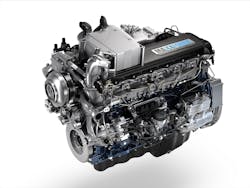EPA to again allow penalties to certify diesel engines
The U.S. Environmental Protection Agency (EPA) has issued its Final Rule Noncomformance Penalties (NCPs) that allow engine makers to produce and sell “heavy heavy-duty diesel engines” that do not meet the agency’s current 2010 NOx emission limit by paying penalties to the federal government on a per-engine basis.
The Final Rule keeps the NCP avenue to the engine marketplace open and that is very good news for Navistar, which had depended on paying the penalties to enable it to continue supplying engines to truck OEMs while it continued working to achieve full EPA- 2010 compliance for the engines it manufactures with a solution that includes SCR technology.
EPA’s Interim Rule on NCPs had been dismissed by the U.S. Court of Appeals for the District of Columbia Circuit. The court, ruling on a lawsuit brought by Navistar competitors Cummins Inc.; Daimler Trucks North America and its subsidiary Detroit Diesel; and by sister OEMs Mack Trucks and Volvo Trucks North America, said EPA erred when it issued a rule allowing Navistar to pay NCPs on engines that did not meet EPA rules requiring less than 0.20 grams of NOx.
“We are pleased that the U.S. Environmental Protection Agency has issued the Final Rule for Nonconformance Penalties (NCPs) for on-highway heavy heavy-duty diesel engines,” said Troy Clarke, Navistar’s president & COO, in a statement.
“We can now provide our dealers and customers with clarity and certainty as we transition to our clean engine technology and look forward to utilizing the Final Rule as needed,” he continued.
Clarke added that “Implementation of the Final NCP Rule will have no impact on our vehicles previously certified by the EPA under the Interim NCP Rule.”
EPA Administrator Lisa Jackson yesterday signed the Final Rule. Its summary stated that the agency is “taking final actionto establish nonconformance penalties (NCPs) for manufacturers of heavy heavy-duty diesel engines (HHDDE) in model years 2012 and later for emissions of oxides of nitrogen (NOx) because we have found the criteria for NCPs in [Interim NCP Rule] 40 CFR 86.1103-87 and the Clean Air Act have been met.”
EPA said NCPs allow a manufacturer of heavy-duty engines whose engines do not conform to applicable emission standards, but do not exceed a designated upper limit, to be issued a “certificate of conformity” upon payment of a monetary penalty to the U.S. Government.
EPA pointed out that the “upper limit associated with these NCPs is 0.50 grams of NOx per brake horsepower-hour (g/bhp-hr). This Final Rule specifies certain parameters that are entered into the preexisting penalty formulas along with the emissions of the engine and the incorporation of other factors to determine the amount a manufacturer must pay. Key parameters that determine the NCP a manufacturer must pay are EPA’s estimated cost of compliance for a near worst-case engine and the degree to which the engine exceeds the emission standard (as measured from production engines).”
EPA noted in its Final Rule summary that it has proposed NCPs for “medium heavy-duty diesel engines” as well. However, the agency stated that it is “not taking final action with regard to NCPs for these engines at this time because EPA has not completed its review of the data and comments regarding these engines.”
An unrelated development that also occurred yesterday, per a Chicago Tribunenews story, “Navistar said Thursday it will resort to involuntary layoffs to meet its ‘targeted cost reduction goals,’ according to a filing with the Securities and Exchange Commission. Navistar expects the costs associated with buyouts and layoffs to be between $40 million and $60 million.”
